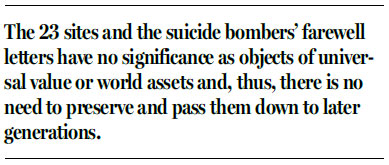New Japanese sites on UN heritage list have negative historic value
Updated: 2015-07-18 08:06
By Cai Hong(China Daily)
|
||||||||
By including Japan's controversial sites in its World Heritage list, the United Nations Educational, Scientific and Cultural Organization has helped Japan cover or glorify one of its past wartime atrocities. The 23 sites include coal mines, steel works and shipyards from 1850 to 1910 that exemplify how Japan became the first Asian nation to enter the modern industrial age.
Japan has a great deal to be proud of when it comes to its rapid modernization and industrialization beginning in the mid-1800s, which launched it on the path to becoming the world's second-largest economy scarcely one generation after the devastation of World War II, although it has slipped to the third now.
But seven of the 23 sites are questionable because some 60,000 Koreans and thousands of Chinese and Allied prisoners of war were forced to work there in support of imperial Japan's war efforts. Japan wants the world to recognize these sites as important historical landmarks in its modernization process and acknowledge their contribution to Japan's development as the first industrial power outside Europe and North America.
But the way it wants to cover the ugliness and cruelty of the forced used of labor is not only insulting but also provocative. Japan is trying to establish the roots of its current economic success in the late 19th century but disconnect them from the period during the 20th century when "slave labor" became widespread in the context of colonialism and war. These characteristics fail to display the "universal values" required for World Heritage Site listing.

Japan seems desperate to get its sites and materials on UN lists, even though some of them defy world opinion and common sense. Last year, Minami-Kyushu city in southern Japan applied unsuccessfully to get the farewell letters written by WWII suicide fighters, known as kamikaze, on United Nations world memory list.
The kamikaze, or "divine wind", program from Chiran, which ran from March until July 1945, was part of Japan's last-ditch effort to turn the tide of a war it was losing badly as the United States and other Allied powers drew closer to the Japanese mainland. Hundreds of young pilots were ordered to fly their hastily built planes into US warships in a desperate bid to slow the Allied advance.
Japanese nationalists eulogize the pilots as "super-patriots" who willingly sacrificed their lives for their country and wartime Emperor Hirohito, but critics say many were forced into accepting the suicidal mission against the Allied forces.
Japan has translated 333 letters by the kamikaze pilots into English and displayed them in a hall in Kagoshima. It plans to nominate them as UNESCO world documentary heritage, without realizing they are nothing but symbols of the cruelty that characterized fascist Japan.
In a statement to the UN cultural body for the 23 sites, the Japanese delegation said it was "prepared to take measures that allow an understanding that there were a large number of Koreans and others who were brought against their will and forced to work under harsh conditions in the 1940s at some of the sites, and that, during WWII, the government of Japan also implemented its policy of requisition". It added that it was also prepared to "incorporate measures into the interpretive strategy to remember the victims such as the establishment of (an) information center".
It is definitely a lesson the world should always remember, but it is significant only as a reflection of a country's mistakes and as a lesson of history. The 23 sites and the suicide bombers' farewell letters have no significance as objects of universal value or world assets and, thus, there is no need to preserve and pass them down to later generations. They are examples that go against the very purpose why UNESCO selects world heritages.
The author is China Daily's Tokyo bureau chief. caihong@chinadaily.com.cn

(China Daily 07/18/2015 page5)
- Global health entering new era: WHO chief
- Brazil's planning minister steps aside after recordings revelation
- Vietnam, US adopt joint statement on advancing comprehensive partnership
- European border closures 'inhumane': UN refugee agency
- Japan's foreign minister calls A-bombings extremely regrettable
- Fukushima impact unprecedented for oceans: US expert

 Stars of Lijiang River: Elderly brothers with white beards
Stars of Lijiang River: Elderly brothers with white beards
 Wealthy Chinese children paying money to learn British manners
Wealthy Chinese children paying money to learn British manners
 Military-style wedding: Fighter jets, grooms in dashing uniforms
Military-style wedding: Fighter jets, grooms in dashing uniforms
 Striking photos around the world: May 16 - May 22
Striking photos around the world: May 16 - May 22
 Robots help elderly in nursing home in east China
Robots help elderly in nursing home in east China
 Hanging in the air: Chongqing holds rescue drill
Hanging in the air: Chongqing holds rescue drill
 2.1-ton tofu finishes in two hours in central China
2.1-ton tofu finishes in two hours in central China
 Six things you may not know about Grain Buds
Six things you may not know about Grain Buds
Most Viewed
Editor's Picks

|

|

|

|

|

|
Today's Top News
Liang avoids jail in shooting death
China's finance minister addresses ratings downgrade
Duke alumni visit Chinese Embassy
Marriott unlikely to top Anbang offer for Starwood: Observers
Chinese biopharma debuts on Nasdaq
What ends Jeb Bush's White House hopes
Investigation for Nicolas's campaign
Will US-ASEAN meeting be good for region?
US Weekly

|

|







